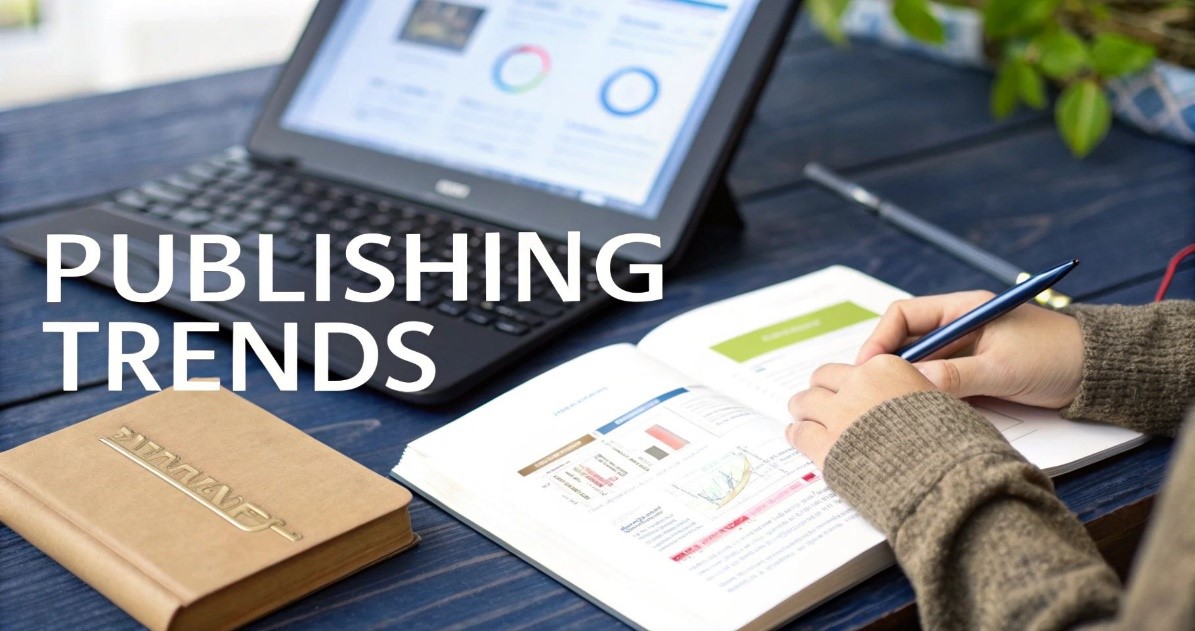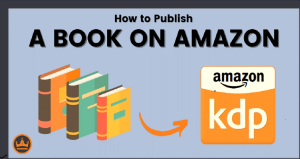The publishing world is expanding with technological advancements, and new publishing modes have reformed the publishing landscape. The transition from book printing to e-publishing signifies that digital ecosystems have become dominant in the publishing industry. Self-publishing platforms have reformed the author’s role, offering autonomy and creative control in manuscript production to design, publishing, marketing, and distribution. E‑book ecosystems, print‑on‑demand, and hybrid publishing have streamlined the publishing process. Contemporary publishers are now reallocating from print runs to digital discoverability. They have tapped into the digital marketplace for accessibility, convenience, and versatility in content production, innovations in marketing, and distribution. Recognizing the importance of digital transformation in publishing, novice authors and publishers have kept pace with the latest trends in the industry. Adapting diverse publishing channels, such as traditional, self-publishing, and hybrid publishing modes, offers new authors lucrative benefits.
If you are an inexperienced indie author and are facing numerous publishing challenges, and have no idea how to create high-quality content that meets publishing standards. In such a case, it is preferable to seek assistance from traditional book publishing companies that facilitate throughout the publishing process. For instance, a leading book writing service, such as David McKay Publications, has experienced content developers and subject-matter experts who collaborate with authors on manuscript production. It involves conceptualizing a narrative storyline, creating exciting settings, a unique theme, and characterization. Proficient editors and proofreaders facilitate writers with comprehensive editing of the manuscript to enrich the text, vocabulary, and structure of the book. Along with editorial assistance, the marketers also plan marketing campaigns and brand strategies to promote paperback to physical retailers and bookstores. Having diversified distribution centers and networks, traditional publishers provide professional support in promoting and launching new publications in global markets. The printed and e-books are promptly delivered to a vast audience using digital resources and robust delivery networks.
However, traditional publishing has drawbacks such as a time-consuming and lengthy publishing process, loss of creative control over book production and design. Reduced royalty rates and the burden of finding a reliable literary agent are the other publishing hassles.
In contrast, opting for self-publishing benefits authors with the convenience of managing the entire publishing process independently. A self-publishing model also offers higher royalty rates as compared to traditional publishing and publishes and delivers the books to a global audience rapidly.
Another publishing mode, Hybrid publishing, is a combination of the traditional and self-publishing models. In comparison to traditional publishing, hybrid publishers enable authors to pay upfront costs to access editing, book cover design, and layout, marketing, and distribution services. In recompense, the author receives a larger share of royalties.
Understanding the Two Publishing Paths
Traditional Publishing
Traditional publishing houses act as a full-service partner, facilitating authors with content creation, manuscript editing, designing book covers, marketing, and distribution services. The major book publishers, such as David McKay Publications, offer publishing support to authors without charging any upfront costs. They proficiently manage the entire publishing responsibilities. The expert editors and proofreaders review the different aspects of the book. They analyze plot, character, structure, and pacing in the manuscript. The line and copy editors meticulously review grammatical and punctuation errors, refine vocabulary, and remove redundant words and paragraphs to develop flow and clarity in the narrative. A comprehensive proofreading of the finished version involves proofreaders working in collaboration with authors and the production team to improve formatting, the interior layout, develop eye-catching book covers, and enhance the content quality.
The in-house marketing team at David McKay company develops marketing campaigns that run across different digital touchpoints. They also create pre-book launching and post-book publishing and launching events, such as organizing book tours, podcast appearances, book signings, and online Q&A sessions. The publishing house sends review copies to media outlets and influencers that boost the author’s visibility and increase book sales. Publishing houses have established distribution networks that promote books into physical bookstores and digital publishing platforms.
Self-publishing Platform
A highly lucrative self-publishing platform allows authors to execute their complete author responsibility and control in book creation, design, and refine the content and structure. Exercising their publishing autonomy, self-publishing authors utilize online publishing platforms, including Amazon KDP, Draft2Digital, or IngramSpark.
David McKay Publications facilitates authors with both traditional publishing and Amazon publishing and distribution. The authors select a platform based on their book genre and upload their finished files to that platform. The publishing site converts the files into print and digital formats and instantly distributes both e-books and print versions to physical and online retailers. From manuscript production to creating a masterpiece, specialized self-publishing services empower authors with increased accessibility and creative control over the book production, design, marketing, book release, and prompt distribution of manuscripts to the global world.
Cost Comparison in 2025
Traditional Publishing Costs
Editing Expenses
Evaluating the traditional publishing cost includes covering pre-publication expenses. The authors utilize $800 to $10,000 for complete manuscript editing. The structural editing involves a cost that ranges from $2,000 to $10,000. An in-depth copyediting and correcting grammar, punctuation, and syntax errors allows authors to pay costs from $500 to $5,00.The final proofreading cost of the manuscript varies from $500 to $3,000 based on the length of the book and the extent of editing.
Book Cover Design Cost
To create an outstanding professional cover design, the publishing company hires a designer who enriches the artistic and structural aspects of a book cover. Cover design costs range from $500 to $3,000 or more, depending on the complexity of the design or the need for custom illustrations.
Royalty Share
Traditional publishers pay a royalty share of around 5-15% for print books and 20-25% for e-books based on the book format and sales percentage.
Marketing Campaign Cost
Book publishing companies allocate $1,000 to $5,000 to create professional campaigns. It includes social media to email marketing campaigns, website, and online ad campaigns. The costs vary depending on the scope and requirements of the campaign.
Hidden Costs
The hidden expenditures include the cost of promotional materials. Publishing hidden expenditures covers venue rent fees, indexing, ISBNs, copyright registration, advertising costs, and third-party subscription costs. Website and online marketing costs comprise domain registration, web hosting, and website maintenance. The hidden distribution cost includes transportation costs for dispatching printed books, warehouse storage, packaging costs, and customs fees. The operation and maintenance costs of distribution centers include rent, utilities, and labor.
Self-Publishing Costs
Editing
If you are a new self-publisher and planning to publish your first manuscript, you need to evaluate your publishing expenses and resources. It includes editing and proofreading expenses. If you lack self-editing expertise, you have a better option to avail self-publishing companies’ services. It requires you to allocate a budget of around $1,000–$5,000+. It comprises the cost of hiring a professional book editor. The cost varies depending on the manuscript’s word count or hourly rate. The author pays an average cost of $2,720 for developmental editing of the book. The copy editing involves a cost $2,000 or more, depending on the word count and size of the manuscript. $1,440 is paid for final checking of the book, including content quality, formatting, spelling, punctuation, typo errors, and enriching the aesthetics of the book.
Book Design Costs
An estimated cost of designing front and back covers ranges from $200 to $1000+. The cost includes hiring an experienced book designer or book publishing service. The author also pays the charges for print or e-book covers, concept development, and spine design that covers the book title, author’s name, and publisher’s name.
ISBN & Copyright
The self-publishers who lack knowledge of ISBN and copyright seek professional publishing assistance. David McKay Publications helps indie authors learn about ISBN costs. For a single ISBN, they have to pay the charges of around $125–$300. If authors have published multiple formats, such as paperback and an ebook, they need a separate ISBN for each format of the book. Purchasing a pack of ISBNs for different formats appears to be cost-effective for indie authors, as the charges for 10 ISBNs are $29.50, and for 100 ISBNs, the amount is $575.Thus, the acquisition of an ISBN allows authors to retain their publishing rights and leads to the smooth distribution of books.
Printing & Distribution
If you opt for e-publishing, you have to pay the cost of converting your file into an e-book. The authors use various e-book creator tools, such as Kindle Create, to format and export files in EPUB and PDF formats. The total expenses range from $0-$350 and more, based on the book length, images, typography, and layout.
Self-publishing through leading online platforms such as Amazon KDP, Lulu, Apple Books, Bookbaby, and Barnes & Noble is free for authors. They can upload and change the format of the manuscript as required. However, some publishing platforms levy additional costs ranging from $0-$1200+ for printing the manuscripts. Some self-publishing platforms also demand authors to pay an extra amount, such as $4–$6 per copy, to avail print-on-demand services.
Marketing Cost
The cost of promoting print and e-books allows authors to allocate an amount from $500-$5,000+, depending on the marketing campaigns launched on different digital touchpoints. For instance, it includes the cost of hiring a book marketing company that manages marketing plans and strategies to boost manuscript promotion. Paid advertising on Google and Facebook costs around- $5-$100 or more per month. For Amazon advertising, the author pays $0.05-$10 per click. $200-$3000 is utilized to create an author’s website.
Email marketing costs range from $100-$1200, depending on launching an extensive email campaign. Social media marketing campaigns include the cost of setting up a Facebook Page, Instagram profile, and Twitter account. Posting social media posts, blogs, reviews, book trailers, and blurb writing weekly on different channels allows authors to pay a cost $150 to $1000. To execute PR services, the authors allocate $50-$1000 to boost excitement for the new book’s launch.
Royalties & Earnings Potential
Self-published authors earn 35% to 70% royalty share for e-books and 40% to 60% for print-on-demand services. These royalty rates are higher in contrast to traditional publishing.
Hybrid Publishing as a Middle Path
David McKay Publication offers a hybrid publishing model, benefiting authors with both traditional and self-publishing services. The publishing house works in collaboration with authors, offering professional editing, proofreading, formatting, and book cover design services. To avail these publishing services, the authors, in return, pay an upfront cost of $5,000 to $80,000. David McKay Company also ensures cost-effective e-book conversion and quickly produces high-quality printed and published manuscripts. Moreover, the distribution team offers prompt circulation of publications to bookstores and online retailers and also ensures transparent pricing. With hybrid publishing, authors retain their creative autonomy and author rights and receive a larger proportion of royalties than traditional publishing models.
Recapitulate
Whether you are a first-time author or an entrepreneurial author, you must be aware of the fact that there is no one-size-fits-all approach to choosing a book publishing platform. Selecting the best publishing path implies that author analyze their publishing goals, priorities, and resources. If you are a novice author or an inexperienced business owner who needs to establish your publishing niche in the competitive book publishing industry, you need to explore professional book publishing services and book writing services that meet your publishing goals. Emerging publishing houses such as, David McKay Publications have significantly reinvented traditional publishing by introducing new business models. They have expanded their publishing services globally and have emerged as a trusted guide for new authors and publishers. Having experienced editors, designers, marketers, and publicists, they offer high-quality book production, editing, cover design, printing, marketing, and distribution services without charging any upfront cost to the authors. Self-publishing authors who lack professional publishing skills have the option to hire assisted self-publishing companies. David McKay company widely offers assisted self-publishing services. It includes professional editing and proofreading, book design, and formatting for both print and e-books. The other services include Amazon publishing and distribution services.
The publishing houses also encourage writers to opt for hybrid solutions. Adopting an author-centric approach allow indie authors to share the costs of book production, editing, and marketing. The authors pay the upfront cost for accessing manuscript production and distribution service, and also employ their creative control in editing, cover design, and book formatting. The publishers and authors jointly work to create and launch targeted marketing campaigns on digital platforms. Thus, the evolving publishing landscape enthuses modern publishing houses to embrace new publishing trends that help boost published manuscript marketability, distribution and sales across the globe.




